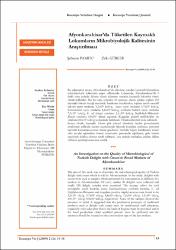Afyonkarahisar’da Tüketilen Kaymaklı Lokumların Mikrobiyolojik Kalitesinin Araştırılması
Abstract
Bu çalışmanın amacı, Afyonkarahisar’da tüketime sunulan kaymaklı lokumların
mikrobiyolojik kalitesinin tespit edilmesidir. Çalışmada, Afyonkarahisar’da 5
farklı satış yerinde dökme olarak tüketime sunulan kaymaklı lokumlar örnek
olarak kullanıldı. Her bir satış yerinden 30 numune olacak şekilde toplam 150
kaymaklı lokum örneği incelendi. İncelenen örneklerden, toplam aerob mezofil
bakteri sayısı ortalama 3,2x106 kob/g, maya sayısı ortalama 5,7x105 kob/g,
Enterobakteri sayısı ortalama 8,4x104 kob/g, koliform bakteri sayısı ortalama
7,5x104 kob/g, E. coli düzeyi ortalama 1,1x104 kob/g, Stafilokok-Mikrokok
düzeyi ortalama 4,9x104 olarak saptandı. Koagulaz pozitif stafilokoklar ise
ortalama 8.0x103 kob/g seviyesinde belirlendi. Örneklerden küf izole edilmedi.
Sonuç olarak, kaymaklı lokum gibi yöresel ürünlerin üretim proseslerinin
modernize edilerek, üretim aşamalarında hijyenik koşullara uyulması, personel
kaynaklı kontaminasyonun önüne geçilmesi, özellikle hijyen kurallarının temeli
olan tuvalet eğitiminin önemi konusunda personelin eğitilmesi, gıda üretim
zincirinde kalifiye eleman tercih edilmesi, son ürünün muhafaza şekline dikkat
edilmesi gerektiği sonucuna varıldı. The aim of this study was to determine the microbiological quality of Turkish
delight with cream which is sold in Afyonkarahisar. In the study, delights with
cream were used as samples which presented for consumption in different five
markets in Afyonkarahisar. Of every market 30 delights were collected and
totally 150 delight samples were examined. The average values for total
mesophilic aerob bacteria, yeast, Enterobacteriacea, coliform bacteria, E. coli
Staphylococcus-Micrococcus and coagulase positive staphylococcus were found to be
3,2x106 cfu/g, 5,7x105 cfu/g, 8,4x104 cfu/g, 7,5x104 cfu/g, 1,1x104 cfu/g,
4,9x104 cfu/g, 8.0x103 kob/g, respectively. None of the samples showed the
presence of mold. It suggested that the production processes of traditional
products such as delight with cream must be modernized, staff education,
espaecially toilet education that is the basis of hygiene must be provided and in
the food production chain qualified persons must be preferred and the
attention should be focused on the conservation type of the last product.
Source
Kocatepe Veteriner DergisiVolume
2Issue
2Collections
- Cilt 2 : Sayı 2 [11]



















